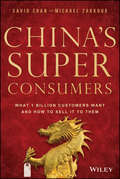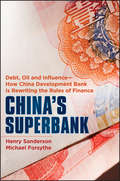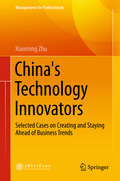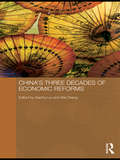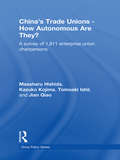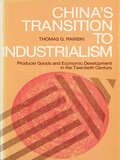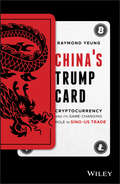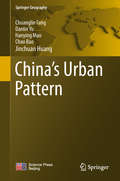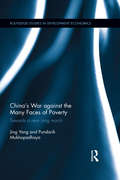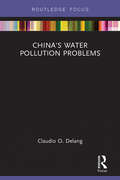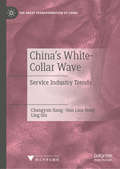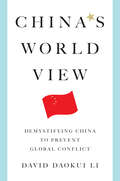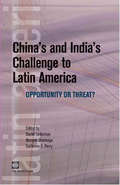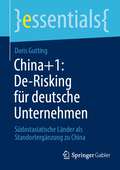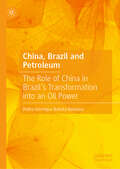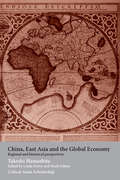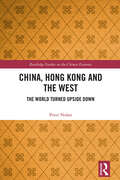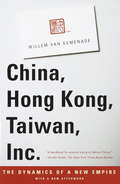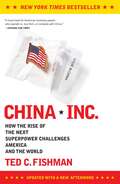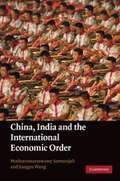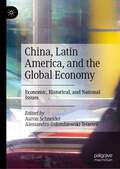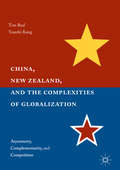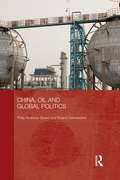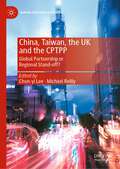- Table View
- List View
China's Super Consumers: What 1 Billion Customers Want and How to Sell it to Them
by Savio Chan Michael ZakkourChinese Consumers are Changing The World – Understand Them and Sell To Them China has transformed itself from a feudal economy in the 19th century, to Mao and Communism in the 20th century, to the largest consumer market in the world by the early 21st century. China's Super Consumers explores the extraordinary birth of consumerism in China and explains who these super consumers are. China's Super Consumers offers an in-depth explanation of what's inside the minds of Chinese consumers and explores what they buy, where they buy, how they buy, and most importantly why they buy. The book is filled with real-world stories of the foreign and domestic companies, leading brands, and top executives who have succeeded in selling to this burgeoning marketplace. This remarkable book also takes you inside the boardrooms of the people who understand Chinese consumers and have had success in the Chinese market. A hands-on resource for succeeding in the Chinese marketplace Filled with real-world stories of companies who have made an impact in China Discover what the Chinese consumer wants and how to deliver the goods Written by Savio Chan and Michael Zakkour, two leading experts on the Chinese market This book is an invaluable resource for anyone who wants a clear understanding of how China's Super Consumers are changing the world and how to sell to them.
China's Superbank
by Henry Sanderson Michael ForsytheInside the engine-room of China's economic growth--the China Development BankAnyone wanting a primer on the secret of China's economic success need look no further than China Development Bank (CDB)--which has displaced the World Bank as the world's biggest development bank, lending billions to countries around the globe to further Chinese policy goals. In China's Superbank, Bloomberg authors Michael Forsythe and Henry Sanderson outline how the bank is at the center of China's domestic economic growth and how it is helping to expand China's influence in strategically important overseas markets.100 percent owned by the Chinese government, the CDB holds the key to understanding the inner workings of China's state-led economic development model, and its most glaring flaws. The bank is at the center of the country's efforts to build a world-class network of highways, railroads, and power grids, pioneering a lending scheme to local governments that threatens to spawn trillions of yuan in bad loans. It is doling out credit lines by the billions to Chinese solar and wind power makers, threatening to bury global competitors with a flood of cheap products. Another $45 billion in credit has been given to the country's two biggest telecom equipment makers who are using the money to win contracts around the globe, helping fulfill the goal of China's leaders for its leading companies to "go global."Bringing the story of China Development Bank to life by crisscrossing China to investigate the quality of its loans, China's Superbank travels the globe, from Africa, where its China-Africa fund is displacing Western lenders in a battle for influence, to the oil fields of Venezuela.Offers a fascinating insight into the China Development Bank (CDB), the driver of China's rapid economic developmentTravels the globe to show how the CDB is helping Chinese businesses "go global"Written by two respected reporters at Bloomberg NewsAs China's influence continues to grow around the world, many people are asking how far it will extend. China's Superbank addresses these vital questions, looking at the institution at the heart of this growth.
China's Technology Innovators: Selected Cases on Creating and Staying Ahead of Business Trends (Management for Professionals)
by Xiaoming ZhuThis book is one of the first to explore how Chinese companies are feeling the impulse of emerging business trends and seizing opportunities brought by technology innovation. It consists case studies of 7 Chinese companies: 3DMed, Wechat from Tencent, Shanghai GM, CP Group, Alibaba, AutoNavi, and ICBC. Each Chinese company has its unique perspectives and different ways to make transformation and business model adjustments. The book helps fill the gap between the global interest in "Innovate in China" and the limited availability of cases on innovations in the country. It is a valuable reference resource for readers in China and beyond wishing to address challenges in the context of growing digital technologies and overwhelming business trends.
China's Three Decades of Economic Reforms (Routledge Studies on the Chinese Economy)
by Wei Zhang Xiaohui LiuIn the thirty years since China initiated economic reforms and its open-door policy, China has been transformed from a poor nation almost completely isolated from the global economy to an engine of growth of the world economy. China’s dynamic transition has been among the most dramatic developments of recent history; and its economy continues to grow rapidly, with important consequences for China’s own society and environment, as well as for the wider world. This book provides a fascinating insight into a wide range of issues on Chinese economy and its three decades of economic reforms. With well-researched, in-depth and comprehensive coverage of key topics, using the latest research findings, this book covers Chinese monetary policy and financial sector reforms; China’s income disparities; the emergence of China’s business groups; the implications of foreign direct investment and innovation and technological developments. The book will be an indispensable guide to scholars, entrepreneurs, policy-makers and all who are interested in China’s economic affairs.
China's Trade Unions - How Autonomous Are They?: A Survey of 1811 Enterprise Union Chairpersons (China Policy Series)
by Masaharu Hishida Kazuko Kojima Tomoaki Ishii Jian QiaoThis book examines the status of trade unions in contemporary China, exploring the degree to which trade unions have been reformed as China is increasingly integrated into the global economy, and discussing the key question of how autonomous China’s trade unions are. Based on an extensive, grass-roots survey of local trade union chairpersons, the book reveals that although trade unions in foreign owned firms and in firms dealing with foreign firms are beginning to resemble trade unions in the West, in the majority of firms a state corporatist model of trade unions continues, with chairmen appointed by the party, with many of them occupying simultaneously party and trade union positions, and thinking it right to do so, and having power bases and networks in both the party and the trade union, with initiatives for protecting workers’ interests coming from the top down, rather than the bottom up, and with collective negotiation and democratic participation in union affairs continuing to be a mere formality. The book shows how the state - wishing to maintain political stability - continues to regard itself, legitimated by the concepts of "socialism" and "proletarian dictatorship", as the sole arbiter of and protector of workers’ rights, with no place for workers protecting their own interests themselves in the harsh environment of the new market economy. The book concludes, however, that because the different model of industrial relations which prevails in foreign owned firms is formally part of the government system, there is the possibility that this new more Western model will in time spread more widely.
China's Transition to Industrialism (Michigan Studies On China)
by Thomas G. RawskiChina's Transition to Industrialism studies the history and development of a group of industries which have played key roles in China's recent economic gains. Drawing on a wide range of materials, the author focuses on engineering, chemicals, and allied producer industries, showing how the growth of these sectors sparked a dynamic process of development which has spread to encompass the entire Chinese economy. Rawski traces this industrialization process to three distinct sources: vigorous prewar development in the private sector, which created a nucleus of experienced producers in Shanghai and other urban centers; the resource mobilization efforts of the post-1949 Communist government; and a series of economic reforms which relaxed the performance constraints found in other socialist economies and stimulated a burst of innovative activity which has propelled China's economy from the depression of the early 1960s to a record of economic achievement unmatched among the large nations of the developing world.
China's Transitional Economy (Studies on Contemporary China)
by Andrew G. WalderThis collection of essays interprets the successes and failures of China's post-Mao economic reforms and discusses the lessons they provide for the transitional economies of other regions, most notably Eastern Europe. The contributions to the volume draw out the policy and theoretical implications of China's transitional economy, looking at notable features of China's reform path, an analysis of the reform's success, and a discussion of whether this success can be sustained.
China's Trump Card: Cryptocurrency and its Game-Changing Role in Sino-US Trade
by Raymond YeungDiscover the impact of blockchain on the trade relationship between the world’s two largest economies China's Trump Card: Cryptocurrency and its Game-Changing Role in Sino-US Trade grapples with the fascinating issue of the effect of digital currencies on world trade and the relationship between China and the United States in particular. Full of forward-looking insights, solid data analysis, extensive collection of relevant literature and incisive observations, author Raymond Yeung compellingly argues that cryptocurrencies will have a significant role to play in harmonizing geopolitical power struggles. Covering all the subjects required for a full understanding of the future of the Sino-US trade relationship, China’s Trump Card discusses: The looming risks of de-dollarization in the wake of de-globalization The pressing need to construct a new currency standard superior to the fiat money regime in response to the global imbalance. China's diversification of its offshore portfolios to include alternative investments The implications of Facebook's plan to create a blockchain-based digital currency The fact that blockchain offers a fungible asset class option for China's reserves investment, which can be relatively independent of political considerations This book is perfect for business leaders, investors, financial analysts, policymakers, economists, fintech developers and others who have a stake in the outcome of the blossoming trade disputes between the United States and China.
China's Urban Pattern (Springer Geography)
by Chuanglin Fang Danlin Yu Hanying Mao Chao Bao Jinchuan HuangThe book embarks on the tasks to systematically analyze the macro background of the spatial patterns of China’s urban development, the theoretical foundations and framework, and its changing trajectory. From a quantitative perspective, we attempt to evaluate the rationale behind the spatial patterns of China’s urban development and systematically simulate the various scenarios. From the simulation results, we propose the optimizing goals, priorities, models, and strategies for the spatial patterns of China’s urban development. The work in this book attempts to provide constructive suggestions and potential strategies to support the effort to optimize the spatial patterns of China’s urban development. It would be a valuable reference for planning departments, development and reform committees, and science and technology administrative departments at various governmental levels. It could also be a valuable addition to graduate students of urban planning, urban development, urban geography and relevant disciplines.
China's War against the Many Faces of Poverty: Towards a new long march (Routledge Studies in Development Economics)
by Jing Yang Pundarik MukhopadhayaChina’s War against the Many Faces of Poverty measures multidimensional poverty in China and deprivation related to income, education, health issues, living standards and social security. The book adopts a well-developed methodology using three different empirical datasets to analyse aspects of regional diversity across rural and urban and migrant populations of China. The book also analyses the links between development policies considered by the government and the various facets of poverty in light of rapid economic growth and addresses important policy implications. In the existing literature, in-depth research on multidimensional poverty in China is almost non-existent. This book is a pioneer study in this important field of research. With its innovative approach in concepts and methodologies and in its analysis of policy implications make this book a definitive and valuable addition to the literature.
China's Water Pollution Problems
by Claudio O. DelangWater pollution is one of the most serious problems plaguing China today with millions of citizens drinking water unfit for consumption. These abysmal conditions have fuelled increasing social discontent, as people become more concerned by the need to address the pressing issues of water pollution, scarcity, and waste management. This book describes how and why China has ended up in such a dire situation, what the government is doing to address the problem and the difficulties encountered in attempting to reduce pollution. The analysis is based on both gray literature (newspaper articles, NGO reports, Chinese government information) and on academic studies. The gray literature gives a voice to those who suffer from the pollution, their advocates, and government officers, and allows the reader to better grasp the conditions on the ground, and the impact of the air pollution among the people in different areas in China. The academic literature adds a theoretical perspective and brings these different case studies into a broader context. This book will be of great interest to students of environmental pollution and contemporary Chinese studies looking for an introduction to the topic, as well as researchers looking for an analysis of China's environmental problems.
China's White-Collar Wave: Service Industry Trends (The Great Transformation of China)
by Changyun Jiang Qun Lian Hong Ling QiuThis book explores the move from manufacturing towards service industry jobs in China's economic development during the 12th Five-Year Plan period. The service industry now makes up the highest proportion of the GDP and employs the largest number of people in China. In the next Five-Year Plan period, it is necessary to actively push forward the strategic transformation by placing emphasis on the service industry to press ahead with system and mechanism reforms and policy innovations and cultivate diverse, sustainable and continuous forces for driving its growth. Efforts are made to upgrade the service industry to better achieve economic and social development in an innovative, coordinated, green, open, and shared way. This book will be of interest to scholars researching China's future.
China's World View: Demystifying China to Prevent Global Conflict
by David Daokui LiA distinguished Chinese economist offers a timely, essential exploration of China’s perspective on economy, government, society, and its position in the world. Dr. David Daokui Li has served as an advisor to senior Chinese Communist Party leaders as well as major multinational corporations and international economic institutions. Writing in response to the growing anti-Chinese sentiment and alarmed by the threat of war, Dr. Li pulls from his wealth of firsthand experience to demystify contemporary Chinese society and advocate for understanding between China and the West. In this urgently needed and fascinating book, he explains the inner workings of a rising superpower to help the world understand how it works—and how to work with it. In Li’s hands, an economic and political system that often baffles Westerners becomes coherent, sophisticated, and logical. He begins by explaining how two thousand years of history—from Confucian philosophy and ancient imperial dynasties to Communist Party chairmen from Mao to Deng Xiaoping—profoundly influence China’s leadership today. Li brings the reader into high-level meetings he attended with figures including Xi Jinping, showing China’s approach to governance. Many Westerners imagine that China’s economy and society are as rigid and ideological as Soviet Russia. In his far-reaching exploration of the Chinese economy—from state-owned enterprises, private businesses, the stock market, education, media and the internet to real estate, the environment, and much more—Li reveals that China’s economy and society are in fact diverse, dynamic, and flexible. In demystifying contemporary Chinese society, Li helps readers reconceptualize contemporary China and the implications of its growth. He asserts that China’s rise will be beneficial for the global order, holding out the hope that with shared understanding and mutual learning the Chinese and Western systems will eventually find a way to peacefully coexist.
China's and India's Challenge to Latin America
by Daniel Lederman Guillermo E. Perry Marcelo OlarreagaThe economic successes of China and India are viewed with admiration but also with concern because of the effects that the growth of these Asian economies may have on the Latin American and Caribbean (LAC) region. The evidence in 'China's and India's Challenge to Latin America' indicates that certain manufacturing and service industries in some countries have been negatively affected by Chinese and Indian competition in third markets and that LAC imports from China and India have been associated with modest unemployment and adjustment costs in manufacturing industries. The book also provides substantial evidence of positive aggregate effects for LAC economies associated with China's and India's greater presence in world exports, financial flows, and innovation. Chinese and Indian growth is creating new production possibilities for LAC economies, particularly in sectors that rely on natural resources and scientific knowledge.
China+1: Südostasiatische Länder als Standortergänzung zu China (essentials)
by Doris GuttingDieses essential gibt einen aktuellen Überblick über die Hintergründe der im Juli 2023 erstmals veröffentlichten China-Strategie der Bundesregierung und über die südostasiatischen Länder, die als Standortergänzung für eine „China+1“-Strategie in Frage kommen. Spätestens seit 2020 wird die starke Abhängigkeit der deutschen Wirtschaft zunehmend zum Problem. Es empfiehlt sich kein „Decoupling“, sondern ein „De-Risking“: der Auf- und Ausbau von Beziehungen zu weiteren Ländern in der Region, um zu diversifizieren und damit Risiken zu mindern. Dieses Buch will aufzeigen und erklären: Was sind die Gründe der neuen China-Strategie und welche Länder kommen als Standortergänzungen in Frage?Ein Buch für alle, die in China unternehmerisch tätig sind und über strategische Standortergänzungen und -alternativen nachdenken.
China, Brazil and Petroleum: The Role of China in Brazil’s Transformation into an Oil Power
by Pedro Henrique BarbosaThis book explores how China-Brazil relations have been impacted by the oil-related bilateral trade, investments, infrastructure projects and financing – an increasingly consequential aspect of Sino-Brazilian relations, which sheds light on China's energy security concerns and its relationship with oil-rich countries more generally. This book depicts in detail how China’s quest for petroleum has been helping Brazil become an oil power. Written by a Brazilian career diplomat that completed a PhD in Mandarin on the topic of this publication and whose insights into Chinese economics, politics and energy policies are deep, this book will interest scholars, diplomats, economists and professionals in the oil sector.
China, East Asia and the Global Economy: Regional and Historical Perspectives (Asia's Transformations/Critical Asian Scholarship)
by Takeshi HamashitaTakeshi Hamashita, arguably Asia's premier historian of the longue durée, has been instrumental in opening a new field of inquiry in Chinese, East Asian and world historical research. Engaging modernization, Marxist and world system approaches, his wide-ranging redefinition of the evolving relationships between the East Asia regional system and the world economy from the sixteenth century to the present has sent ripples throughout Asian and international scholarship. His research has led him to reconceptualize the position of China first in the context of an East Asian regional order and subsequently within the framework of a wider Euro-American-Asian trade and financial order that was long gestating within, and indeed contributing to the shape of, the world market. This book presents a selection of essays from Takeshi Hamashita's oeuvre on Asian trade to introduce this important historian's work to the English speaking reader. It examines the many critical issues surrounding China and East Asia's incorporation to the world economy, including: Maritime perspectives on China, Asia and the world economy Intra-Asian trade Chinese state finance and the tributary trade system Banking and finance Maritime customs.
China, Hong Kong and the West: The World Turned Upside Down (Routledge Studies on the Chinese Economy)
by Peter NolanThis book analyses Hong Kong’s history from a long-run perspective. It examines Britain’s relationship with the city in the context of Hong Kong’s location within the Pearl River Delta and its strategic position within East Asia.Britain’s interaction with Hong Kong commenced in the 1830s. Britain was at the zenith of its economic, political, cultural and military power, while China was approaching the lowest point in its history. The violence and humiliation of the Opium Wars propelled China into a century of economic, political and psycho-social crisis. Two centuries later the position of China and Britain has turned upside down. Hong Kong has returned to China and is part of the hugely dynamic Greater Bay Area. Britain, the First Industrial Nation, has entered an era of deep economic, political and cultural crises. It is at the forefront of the psycho-social crisis across the West, which was exposed dramatically by the landslide victory of Donald Trump in the US election.Placing the history of Hong Kong in a long-run perspective, the book will be of interest to academics and students within the fields of international relations, development studies, China and East Asian studies, as well as business practitioners and policy makers.
China, Hong Kong, Taiwan, Inc.
by Willem Van KemenadeOn the eve of June 30, Hong Kong was officially passed back to China. This event will mark what Willem van Kemenade sees as the start of an increasingly problematic -- and even dangerous -- reintegration of the old Chinese empire into a new world superpower. Since the early 1980s, investment money has been pouring into China from Hong Kong and trade has escalated at a rocket's pace. A few years later, the same pattern began between China and Taiwan. The combination of Hong Kong/Taiwan management, financial and export know-how with China's inexhaustible pool of cheap labor and land has enabled China in one decade to leap from an impoverished revolutionary state to a major international trading power. This economic boom, in conjunction with the violation of intellectual property rights, systematic tax fraud, and the corruption of the police force, has helped shape the "socialist market economy," China's third way -- and a new mix of old-fashioned Soviet Communism and East Asian capitalism.The formal addition of Hong Kong will add to this mixture the democratic structures set in place by the British. And, as China moves to reclaim Taiwan (the process has already begun), it will be incorporating a rival Chinese sub-nation with a fully election-based political system and a powerful independence movement. Can such a reunified China resist the "spiritual pollution" of democratic values, human rights, and political freedom? Will it become the first depoliticized "corporatist superpower"? What are the prospects that reunification will be peaceful?Van Kemenade's portrait of the true internal power structures of the three Chinas provides our clearest look yet at the fastest-rising new empire in the world today.From the Trade Paperback edition.
China, Inc.: How the Rise of the Next Superpower Challenges America and the World
by Ted C. FishmanChina today is visible everywhere -- in the news, in the economic pressures battering america, in the workplace, and in every trip to the store. provocative, timely, and essential, this dramatic account of china's growing dominance as an industrial super-power by journalist Ted C. Fishman explains how the profound shift in the global economic order has occurred -- and why it already affects us all. How has an enormous country once hobbled by poverty and Communist ideology come to be the supercharged center of global capitalism? What does it mean that China now grows three times faster than the United States? That China uses 40 percent of the world's concrete and 25 percent of its steel? What is the global impact of 300 million rural Chinese walking off their farms and heading to the cities in the greatest migration in human history? Why do nearly all of the world's biggest companies now have large-scale operations in China? What does the corporate march into China mean for workers left behind in America, Europe, and the rest of the world?Meanwhile, what makes China's emerging corporations so dangerously competitive? What could happen when China will be able to manufacture nearlyeverything-- computers, cars, jumbo jets, and pharmaceuticals -- that the United States and Europe can, at perhaps half the cost? How do these developments reach around the world and straight into the lives of all Americans?These are ground-shaking questions, andChina, Inc. provides answers. Veteran journalist and former commodities trader Ted C. Fishman paints a vivid picture of the megatrends radiating out of China. Fishman's account begins with the burgeoning output of China's vast low-cost factories and the swelling appetite of its 1. 3 billion consumers, both of which are being driven by historically unprecedented infusions of foreign capital and technological know-how. Traveling through China's frenetic landscape of growth, Fishman visits the factories, markets, streets, stores, towns, and cities where the story of Chinese capitalism is being lived by one-fifth of all humanity. Fishman also draws on interviews with Chinese, American, and European workers, managers, and executives to show how China will force all of us to make big changes in how we think about ourselves as consumers, workers, citizens, and even as parents. The result is a richly engaging work of penetrating, up-to-the-minute reportage and brilliant analysis that will forever change how readers think about America's future.
China, India and the International Economic Order
by Muthucumaraswamy Sornarajah Jiangyu WangWith contributions by a variety of internationally distinguished scholars on international law, world trade, business law and development, this unique examination of the roles of China and India in the new world economy adopts the perspectives of international economic law and comparative law. The two countries are compared with respect to issues concerning trade and development, the World Trade Organization, international dispute settlement, regional/free trade agreements, outsourcing, international investment, foreign investment, corporate governance, competition law and policy, and law and development in general. The findings demonstrate that, though their domestic approaches to economic issues diverge, China and India adopt similar stances at the international level on many major issues, recapturing images which existed during the immediate post-colonial era. Cooperation between China and India could provide leadership in the struggle for economic development in developing countries.
China, Latin America, and the Global Economy: Economic, Historical, and National Issues
by Aaron Schneider Alessandro Golombiewski TeixeiraThis book seeks offers accounts of the ways in which Chinese engagement with Latin America will shape the regional and global order with impacts for development, peace, and equity. It also pays close attention to the traditional role played by the USA in the region, how China differs, and the increasingly triangular relationship between the USA, China, and Latin American countries. The contributors analyze various economic dimensions, including trade, infrastructure, and finance, and the historical, sectoral, regional, and national stories seek to change the narrative on China-Latin American relations. In particular, the book argues that there are opportunities for international cooperation to secure gains in the region, but only if the US and China alter their behavior and Latin American countries work collectively and in more coordinated fashion. Together, the chapters offer coherent social science analysis, policy frameworks, and empirical detail to understand and navigate increased Chinese engagement with Latin America.
China, New Zealand, and the Complexities of Globalization: Asymmetry, Complementarity, and Competition
by Tim Beal Yuanfei KangThe book examines the expansion of investment and trade between China and New Zealand, and its changing composition within the political framework, especially the 2008 Free Trade Agreement. Particular attention is paid to China's volatile agrifood market, where New Zealand dairy products play an important role for both countries. The New Zealand-China economic relationship - asymmetrical and complementary, but with increasing competition from domestic production - is a case study of the complexities of globalization and the interplay of economic imperatives, political pressures and cultural factors. China is now New Zealand's main economic partner and a major source of migrants, tourists and students. This proposed study on how New Zealand and China manage their grave dissimilarities and disparities in growing, ever close economic ties will be of interest to academics, policy analysts, economic/trade decision makers, and business practitioners.
China, Oil and Global Politics (Routledge Contemporary China Series)
by Roland Dannreuther Philip Andrews-SpeedChina’s rapid economic growth has led to a huge increase in its domestic energy needs. This book provides a critical overview of how China’s growing need for oil imports is shaping its international economic and diplomatic strategy and how this affects global political relations and behaviour. Part One is focused on the domestic drivers of energy policy: it provides a systematic account of recent trends in China’s energy sector and assesses the context and processes of energy policy making, and concludes by showing how and why China’s oil industry has spread across the world in the last fifteen years. Part Two analyses the political and foreign policy implications of this energy-driven expansion and the challenges this potentially poses for China’s integration into the international system. It examines a number of factors linked to this integration in the energy field, including the unpredictabilities of internal policymaking; China’s determination to promote its own critical national interests, and the general ambition of the Chinese leadership to integrate with the international system on its own terms and at its own speed. The highly topical book draws together the various dimensions of China’s international energy strategy, and provides insights into the impact of this on China’s growing international presence in various parts of the world.
China, Taiwan, the UK and the CPTPP: Global Partnership or Regional Stand-off? (Taiwan and World Affairs)
by Michael Reilly Chun-Yi LeeOriginally called the Trans-Pacific Partnership until the USA withdrew in 2017, the Comprehensive and Progressive Agreement for Trans-Pacific Partnership (CPTPP) is an ambitious and wide-ranging free trade agreement between eleven Pacific countries. Far from faltering after US withdrawal, several more countries have since applied to join, including China, Taiwan and the United Kingdom. Some observers see in this a contest between China and the USA for wider influence through an attempt to control or re-write the rules of international trade; at a minimum accession by any of the three would have a major impact on the CPTPP as originally envisaged. This edited volume considers the three applications, the motivations for the three to join, and the likely responses of existing members. The implications for cross-Strait tension between China and Taiwan are fully considered, as is the ability or willingness of the USA to influence the outcome of the applications.
